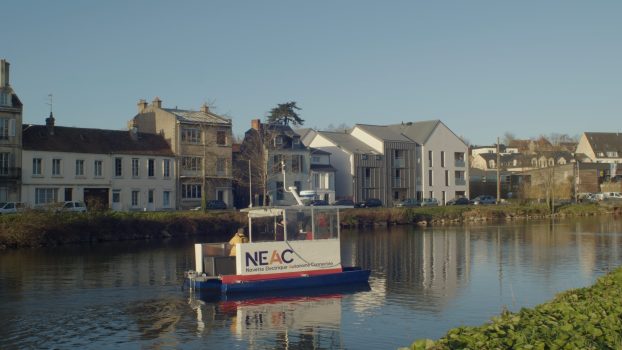Living Lab 2: Caen and Le Havre, France
Overview
Caen: remote control sailing in real life conditions
Caen, located in the northwest of France, is a medium-sized city with approximately 200,000 inhabitants hosting a significant student population thanks to its university.
The hydrographic network of Caen is characterized by the presence of the river Orne, which runs through the city, as well as several canals and waterways that connect it to the sea. These watercourses offer a picturesque landscape and add to the city’s appeal. The Caen to the Sea Canal connects the city to the English Channel, providing a vital link for maritime transport and commerce. Caen’s river system features a variety of infrastructure, from bustling quays to locks and industrial ports. The presence of these facilities contributes to the city’s economic activity, particularly in the transportation, logistics, and tourism sectors.




Le Havre: inter urban virtual simulation
Le Havre offers an estuary environment, which is a great opportunity to work on the design of a coastal barge and the regulations differences between an inland waterway environment and a maritime one. To develop autonomy, and to boost green energy solutions, the test would be simulated, and its data integrated into the project’s digital twin.
The test would include one trip with waste and the return trip with small parcels to be delivered by e-bikes to respect a reverse logistics scenario. A viable business case will have to be developed including the various stakeholders, from hydrogen provider to shipper and to participate to raising awareness among local authorities about H2 regulations and needs.
Facts
- 15 km waterway connecting the port of Caen to the port of Ouistreham
- 3 Bridges: Fonderie, Colombelles, Bénouville (Pegasus Bridge)
- considered as maritime zone
- allowed speed: 4 knots
- 2 Ouistreham locks
- tidal range : 70-80cm
- canal current: low
- depth: 10 m
- max. width: 200 m

Living Lab 2 is dedicated to advancing last-kilometer delivery solutions in urban centers, optimising cost efficiency, reducing CO2 emissions, and bolstering the competitiveness of waterborne transport through the implementation of sustainable, digitised business models. Within this context, Living Lab 2 is actively engaged in the development of a new three hull SFAZ tailored for urban goods transport. Key features include swarm operation, easy manoeuvrability, shallow water navigation capabilities, cyber-secure communications, and the integration of electric thrusters
Main Objectives
Reduction of the carbon footprint & limitation of road traffic
Logistics offer by a consortium combining river freight and last km logistics
Use of new communication technologies (5G) and flow management
Living Lab Test Cases
Remote Control Sailing and
Swarm Autonomy
by exploring advanced techniques for coordinated navigation with a focus on remote control sailing and swarm autonomy.
Designing a Coastal Barge with Auto-Mooring and Energy Solutions
to engineering a coastal barge equipped with auto-mooring capabilities and innovative energy solutions.
Simulating Intra-Urban Deliveries combined with e-bikes
by conducting simulations to optimise estuary deliveries, incorporating the use of e-bikes.
Characteristics
Demonstration environment: (i) small waterway; (ii) intra-urban; (iii) coastal; (iv) estuary; (v) canal
Simulation testing environment: (i) intra-urban; (ii) coastal; (iii) estuary
Satellite-based data & services: Copernicus and Galileo / EGNOS
Key Performance Indicators (KPIs):
Developed stakeholder-aligned business models to further enhance the effectiveness and sustainability of urban goods transport
Implemented measures to achieve a reduction in GHG emissions.
Innovations to be demonstrated:
- Automated / autonomous vessel functions such as navigation functions (steering and manoeuvring in shallow and deep water in different types of weather), engineering functions including identification of the vessel’s environment, algorithm for speed and avoidance course decision-making) and special functions such as cyber security, data flows and vessel integration into land based logistics processes
- Zero-emissions transferability of Living Lab 1 system






